Summary of Gertrude Stein
An avant-garde novelist of some note, Stein is better remembered by art historians for the comings-and-goings at her Parisian apartment, 27 rue de Fleurus, which acted as a social gathering space for a group of young men and women who were destined to become some of century's most important artists. With her brother Leo, Stein became the impoverished artistic community's chief benefactor, and amongst the very earliest collectors of experimental paintings by the likes of Pablo Picasso, Henri Matisse, Juan Gris, and Georges Braque. A matriarch within the Parisian bohemian set, she helped broaden the influence of modernism through her associations with other American writers staying in the city, most notably Ernest Hemingway, F. Scott Fitzgerald, Sherwood Anderson ("the lost generation" as she dubbed them), and Britons including Edith Sitwell and Harold Acton.
Well known for her combustible and eccentric personality, Stein was not short on self-belief either, declaring in her pomp that: "Einstein was the creative philosophic mind of the century, and I have been the creative literary mind of the century". She would, however, make enemies of many in her circle through the publication of a controversial, though hugely popular, autobiography. Stein's place in the folklore of twentieth-century French culture was cemented through her actions during the two World Wars when she gave up her self-interests and dedicated her time to the war wounded and the wellbeing of the scores of American servicemen. In America, meanwhile, Stein was to find lasting fame, first as an iconoclastic literary innovator, and then as a celebrity who amassed a devoted public fan base through her irreverent autobiographical works and her enthralling public appearances.
Accomplishments
- A woman of intimidating drive, Stein saw beyond the prejudices of the existing art establishment, becoming the first important patron to some of the great pioneers of twentieth-century modernism, including Matisse whose career she effectively launched. Her vocal (she could make or break reputations with her judgements on art) and financial interventions went a long way to deciding the future fortunes of those she called the "New Moderns".
- Stein was one of the first to recognize the potential for Picasso's early Cubist works. While most were struggling to comprehend the Cubist agenda, Stein was hailing it as the future of art. She saw in her friend (Picasso) the type of trailblazing spirit she wished for herself. Indeed, her own style of writing sought to parallel in words the Spaniard's experiments in fragmentation and abstraction.
- As her reputation grew, Stein published a series of "portraits" which were written summaries of the lives of many in her artists' circle. These appeared, with photographs from her collection, in America in Alfred Stieglitz's Camera Work magazine and in Arts and Decoration magazine. As such, Stein emerged as the lynchpin between New York and Paris at a time when the magic of the European avant-garde was beginning to generate excitement across the Atlantic.
- Though it caused considerable bad blood between Stein and many of the artists and authors whose lives she had described, her somewhat libelous memoir, The Autobiography of Alice B. Toklas (sic), became a bona-fide best seller. Stein can therefore take credit for her role in introducing the exotic world of the Parisian avant-garde to an audience well outside the usual reach of the select modernist community.
Gertrude Stein and Important Artists and Artworks
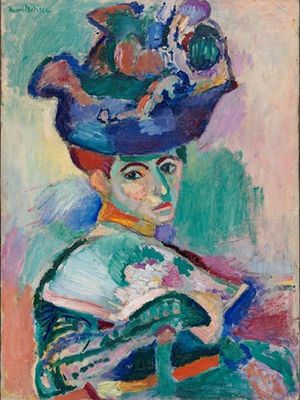
Woman with a Hat (year)
Henri Matisse has depicted his wife, Amélie, in a floral dress and large hat, seated in a chair looking out over her shoulder. Represented in vivid colors and loose, gestural, brushstrokes, the painting caused a scandal when it debuted in the 1905 Paris, Salon d'Automne. One critic was so outraged he called Matisse and other artists painting in this style "fauves" (or "wild beasts"), but in so doing, he or she inadvertently named the movement that would be known henceforward as Fauvism.
The author and critic James R. Mellow argued that for Stein the purchase "seemed perfectly natural and she could not understand why it [had] infuriated everybody". Matisse's biographer and first Director of Museum of Modern Art in New York, Alfred H. Barr, Jr., even referred to the purchase as "an act of considerable courage and extraordinary discernment" (though it is known that Leo had not been so easily persuaded by the painting's merit). The author Janet Hobhouse states that "the Stein family's friendship with the Matisses greatly altered the fortunes of the painter and his wife. They now not only had loyal patrons [...] but an intelligent and responsive audience for work which few others were then willing to support".
Stein developed a close relationship with the artist and described him as a man with, "an astonishing virility that always gave one an extraordinary pleasure when one had not seen him for some time. Less the first time of seeing him than later. And one did not lose the pleasure of this virility all the time he was with one". Unfortunately, Stein's description of the Matisses in her 1932 autobiography The Autobiography of Alice B. Toklas ended their friendship with the artists taking offence to (amongst other things) Stein's comments about his wife's looks which she likened to that of a horse. In 1915 Stein would sell this painting to her brother and sister-in-law, Michael and Sally, in order to secure funds so that she and her partner Alice Toklas could support themselves while they volunteered to support the war effort.
Oil on canvas - Collection of San Francisco Museum of Modern Art, San Francisco
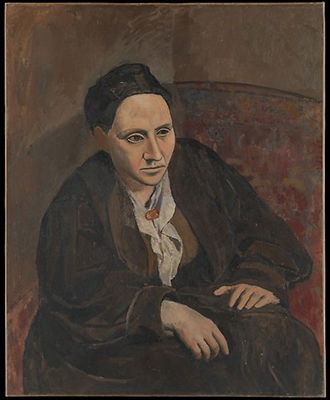
Gertrude Stein (1905-06)
Arguably one of Pablo Picasso's most well-known portraits, Stein is depicted with hair pulled tightly into a bun and dressed in a brown corduroy suit which was the "uniform" that made her stand out from the crowd in the streets, galleries and cafes of Paris. The muted color palette in which the work is rendered was chosen by Picasso in order to direct the viewer's attention directly to Stein's face and her intense gaze. Author and critic James R. Mellow describes how for Picasso "the portrait became a stunning transitional work, lingering at the end of his Rose Period of harlequins and circus subjects. With its brown and somber coloring, its tawny hits of rose in the flesh colors and in the background, the painting represented the autumn of that style. But its sharp and angular characterization of the sitter looked ahead to the approach of Cubism".
Picasso asked Stein if he might paint her portrait not long after he had become a regular guest at 27, rue de Fleurus; the site of many dinners and long evenings of conversation about modern art. His request that Stein sit for him proved something of a turning point for the artists. According to the author Janet Hobhouse, Picasso had not worked with a model in eight years and "over the months that Gertrude came to pose for him at his studio - some ninety sittings in all - their friendship was [truly] formed". Picasso had in fact shown frustration at his inability to truly capture Stein's likeness. According to Mellow, in the spring of 1906, "one day, in a fit of irritability, Picasso had painted out the head. 'I can't see you any longer when I look'" he exclaimed. The artist did manage to "find her again", however, and he completed the painting in Stein's absence.
Oil on canvas - Collection of The Metropolitan Museum of Art, New York
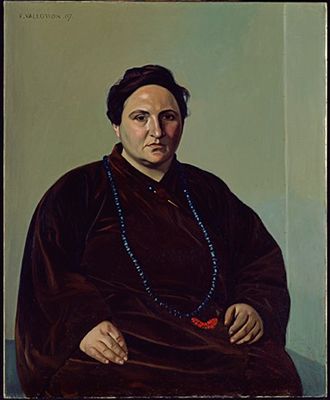
Gertrude Stein (1907)
To show his appreciation for the Steins' purchase of his work for their collection, Swiss painter Félix Vallotton painted this portrait of Gertrude by way of a gift. Author and critic James R. Mellow described his rendering of Stein, "as an august and sleek personage in the loose, brown corduroy robe with a lapis-lazuli mandarin chain [...] which she wore as a sort of official costume at her 'at homes' on Saturday evenings".
This was only the second time Stein had sat for a portrait (after Picasso a year earlier) and she observed the contrast between the two approaches. She said of Vallotton, "when he painted a portrait he made a crayon sketch and then began painting at the top of the canvas straight across". Stein likened the artist's strategy to "pulling down a curtain as slowly moving as one of his Swiss glaciers. Slowly he pulled the curtain down and by the time he was at the bottom of the canvas, there you were". Vallotton never came close to Picasso's fame, nor as close to Stein personally. Mellow argues in fact that Stein's indifferent "feelings about the picture are no doubt reflected in the fact that it never appears in photographs of the studio in early years". This does not mean that Vallotton's portrait was less deserving of its place in Stein's legacy, however. Indeed, according to the Smithsonian's National Portrait Gallery, "in pulling Stein's head back from the picture plane and making her robe a monolithic platform for her massive head and hands, Vallotton rendered her a female Buddha [and by] the late 1920s, his interpretation of Stein as imperious, remote and ageless became the common one".
Oil on canvas - Collection of Baltimore Museum of Art, Baltimore, Maryland
Group of Artists (1908)
A group portrait, Marie Laurencin's painting is a celebration of some of the early twentieth century's greatest talents who became regular visitors to Stein's apartment for her exclusive Saturday evening gatherings. Featured from left to right is a seated Pablo Picasso (his dog on his lap), the artist herself (Laurencin), her partner, the poet and art patron Guillaume Apollinaire, and on the far right, the artist, and Picasso's lover, Fernande Olivier.
Stein had attributed the Saturday evening meetings for the most part to Matisse since it was he who had formed the habit of bringing people to the apartment at all times to admire the paintings of Cézanne. As Stein recalled, "Matisse brought people, everybody brought somebody, and they came at any time and it began to be a nuisance, and it was in this way that Saturday evenings began". The personal value of the painting to Stein was therefore obvious, but the purchase was important for Laurencin too, given that it was the first painting the artist ever sold and thereby effectively launching her career as a professional artist.
Stein's desire to support artists within her community can be traced with this painting when, in 1925, she exchanged the work with dealer Daniel-Henry Kahnweiler for a painting by Juan Gris. Stein did this, not because she has fallen out of love with Laurencin's painting - indeed the painting was, according to the author Janet Hobhouse, "a work of great sentimental value" to Stein - but rather she had felt the need to support the flagging fortunes of Gris who had struggled since the end of the war and through the slow demise of Cubism. Sadly, Stein and Laurencin would later fall out over the content of Stein's 1932 book The Autobiography of Alice B. Toklas. According to Hobhouse, Laurencin felt, "it was wrong to depict the pasts of writers and artists since they always lived in the present [and] without heed to the possibilities of future reporting of those lives". Nevertheless, the author and critic James R. Mellow asserts that Laurencin, "remained grateful to Gertrude's gesture [of early support] even when they were no longer on friendly terms".
Oil on canvas - Collection of Baltimore Museum of Art, Baltimore, Maryland
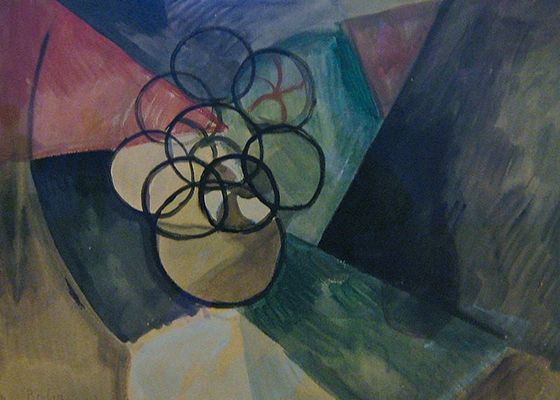
Caoutchouc (1909)
An early work in the oeuvre of Francis Picabia, Caoutchouc provides a good example of his Cubist influences and predates the Dadaist and Surrealist works for which he is much better known. Lacking any depth or dimensionality, Picabia has rendered basic geometric shapes including circles and squares, in loose brushstrokes of various colors. An early supporter of Cubism, and an admirer of Picabia's originality, these abstract works were the pieces Stein responded to most favorably. According to author and critic James R. Mellow, "Picabia's manner changed considerably throughout the twenties [...] and by the thirties he was painting in a representational, somewhat surreal, style with fluidly drawn, transparent figures of humans, animals, and birds. What Gertrude seems to have appreciated in this pastiche of a style was the artist's attempt to solve 'the problem that a line should have the vibration of a musical sound".
While Stein was not a fan of Surrealism, she felt Picabia distinguished himself from others working in that style, stating, "the surréalistes [...] accept the line as having become vibrant and as therefore able to in itself to inspire them to higher flights. He who is going to be the creator of the vibrant line knows that it is not yet created and if it were it would not exist by itself, it would be dependent upon the emotion of the object which compels the vibration". For Stein, Picabia was an artist with the vision and sensitivity to realize any such development.
Watercolor, gouache and India ink on cardboard - Collection of Centre Pompidou, Paris, France
The Architect's Table (1912)
An excellent example of Analytical Cubism, a revolutionary style developed by Pablo Picasso and Georges Braque, Picasso depicts a table strewn with barely discernable objects including drawing and other architect tools. True to this style, the objects are rendered in a muted color palette of various shades of brown and are presented in simplified, flat, overlapping geometric forms that lack any sense of depth or dimensionality.
What distinguished Stein from many of Picasso's other patrons was that she was one of the first to support his Cubist experiments. When others were struggling to understand Cubism, she was already an advocate; perhaps because she recognized in Picasso the same trailblazing spirit that she tried to achieve in her own literary style. That she felt a kinship with Picasso is clear when she told him, "there are two geniuses in art today, you in painting and I in literature". She knew Picasso was creating something hugely significant that would alter the direction of modern art which she acknowledged when she stated, "[Picasso] understands what is contemporary when the contemporaries do not yet know it, but he is contemporary and as the twentieth century is a century which sees the earth as no one has ever seen it".
According to author and critic James R. Mellow, Stein had unintentionally inspired this painting when she and her partner Alice Toklas had visited Picasso's studio. The artist was nowhere to be found so, "as a joke [Stein] left her calling card". Some days later, the couple returned to the studio where they spotted this painting. Stein noticed that "At the bottom of the picture, Picasso had painted in a replica of Gertrude's calling card". She wanted the work so much that, short on funds, she had to arrange a payment installment plan with Picasso's dealer. It was also the first painting Stein bought on her own, without Leo's (who disliked Cubism) input or financial support.
Oil on canvas - Collection of The Museum of Modern Art, New York
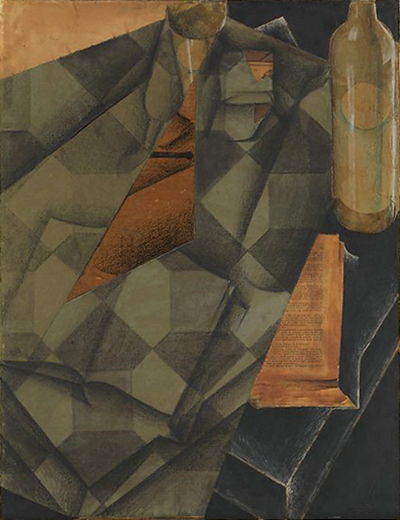
Book and Glass (1914)
Book and Glass was one of the first Gris paintings acquired by Stein. Rendered in a Cubist style of simplified, flattened, geometric forms, Gris depicted a table on which rests a bottle, glass, package of tobacco, and an open book. Upon closer inspection, however, as the Metropolitan Museum details, one can see, "shadowy doubles of each form camouflaged within the blue-checkered design", while a man's upper body can be discerned: "the stemmed drinking glass at top center suddenly appears as a neck and shirt collar; the top diagonal edges of the table are shoulders; the long triangle of shaded brown paper at center is a necktie; and the tobacco packet at upper right is a folded pocket square".
Praising Gris, Stein once stated, "the only real cubism is that of Picasso and Juan Gris. Picasso created it and Juan Gris permeated it with his clarity and his exaltation". Interestingly, she did not take completely to Gris when she first met him, recalling that he was, "a tormented and not particularly sympathetic character [who] was very melancholy and effusive and as always clear sighted and intellectual". Stein would became very fond of Gris in later years, especially so as he stayed true to Cubism long after others (including Picasso) had left the movement behind. Stein also supported Gris when he needed it most and, according to author Janet Hobhouse, "most of the other Cubists [in the years after the First World War] had by then become too successful to need her patronage (and their paintings had become too expensive for her to buy), but Gris had suffered for a long time from both poverty and ill-health and very much depended on [Stein's] support to stay alive." Upon his death in 1927, she wrote a tribute to him for an issue of Transition magazine titled "The Life and Death of Juan Gris".
Conté crayon, charcoal, wax crayon, watercolor, gouache, oil, paper, honeycomb panel - Collection of Metropolitan Museum of Art, New York
Biography of Gertrude Stein
Childhood and Education
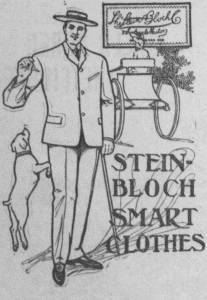
Gertrude Stein was the youngest of five children. When she was one year old, her father, Daniel, abandoned the family clothing business (Stein Bros.) following a falling out with his brother and moved with his wife (Amelia) and his children to Vienna. The Stein's moved again to Paris (via Passy) when Gertrude was four years old before returning to America in 1879. Having spent a year in Baltimore they settled finally in Oakland California in 1880.
Stein enjoyed a comfortable childhood but she found it difficult to interact with other children. To compensate, she formed a close bond with her brother Leo of whom she later wrote, "it is better if you are the youngest girl in a family to have a brother two years older, because that makes everything a pleasure to you, you go everywhere and do everything while he does it all for you and with you which is a pleasant way to have everything happen to you".
Though she retained a special fondness for her oldest sibling Michael, the author Janet Hobhouse observed that Leo and Gertrude regarded themselves as "superior creatures who ignored as best they could the existence of other members of their family, and the pressures of what discipline there was". Hobhouse adds that the pair didn't care for either of their parents and Gertrude welcomed their premature passing. Stein said of her mother's death from cancer in 1885, "we had already had the habit of doing without her" while on the event of her father's demise in 1891, she stated, "our life without a father began a very pleasant one" in which the twenty-six-year-old Michael took over day-to-day parental responsibilities.
Early Training
When Stein was eighteen she left California to live briefly with her mother's family in Baltimore. Missing Leo, however, she followed him to Massachusetts where he was attending Harvard. To be near him, she enrolled at the Harvard Annex (the women's school today known as Radcliffe) in 1894. At first it was as a "special student", a status given to students with no high school degree. However, Stein worked assiduously to achieve full student status and focused her college studies on psychology and philosophy under the "father of American psychology", William James. Indeed, encouraged by James, Stein published two research papers in the Harvard Psychological Review before enrolling at the Johns Hopkins Medical School.
It was at John Hopkins School that Stein experienced new personal freedoms; exploring her own sexuality through her first love affair with a woman. While she enjoyed the social side of academic life, Stein began to lose interest in her studies and, in 1902, after failing her exams, she left school for good, joining Leo in London where he had been living for the last year.
Mature Period
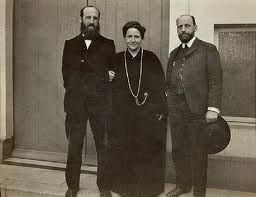
Gertrude and Leo settled in Paris in the fall of 1903, moving into what was destined to become one of the city's most famous apartments: 27, rue de Fleurus: "Paris was the place that suited us who were to create the twentieth century art and literature", she stated later. Stein, who had begun to take writing seriously by this time, had also became interested in art due largely to Leo who had been studying painting. Associating with figures such as dealer Amboise Vollard, Leo and Gertrude began collecting modern art based purely on their aesthetic preferences (not as investments in other words). Vollard considered the Steins among his favorite customers, and according to author and critic James R. Mellow, "they were the only clients who bought pictures 'not because they were rich, but despite the fact that they weren't". Among those early works were numerous paintings by Paul Cézanne and Henri Matisse; with one of their most notable purchases being Matisse's controversial Woman with a Hat (1905). Around this time, Stein's older brother Michael moved his family to Paris and began to collect modern art too; marking the beginnings of a true family enterprise.
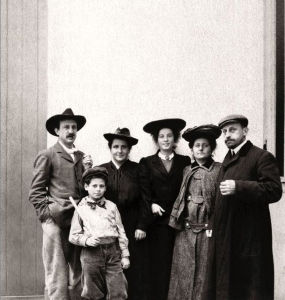
Gertrude and Leo began to host Saturday evening dinners in the apartment where people gathered to examine the paintings and discuss their merits (or demerits). Together, Gertrude and Leo developed quite the reputation as eccentrics which, according to Hobhouse, included, "their irregular behavior and dress: their cigar smoking and loud laughter in public places (they were barred from the Café Royal); [and] the brown corduroy suits which they wore with sandals (even in winter)". Initially it was Leo that led the group gatherings, but Gertrude soon began to assert her own authority. Such was her insight she would soon start to play a key role in shaping the careers of her patrons. The sales income undoubtedly helped the artists involved, but more importantly the "exhibition" of the purchased work in the Steins' apartment brought them fresh attention from the many visitors who would then themselves often become patrons. Moreover, artists who visited the apartment were able to take inspiration from the likes of Europeans Juan Gris, Marie Laurencin and Francis Picabia; and Americans including Marsden Hartley, Alfred Maurer, and Morgan Russell.
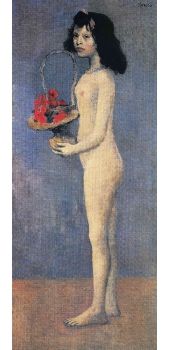
The lifelong friendship between Stein and Pablo Picasso began in 1905. Stein was not at all taken with the first paintings Leo purchased, one of which was the Spaniard's Young Girl with a Flower Basket (1905). Indeed, when Leo boasted to his sister of his new acquisition over dinner, she told him he had "spoiled her appetite". Her attitude changed quickly however and Stein took an instant liking to Picasso when he had joined her for dinner at the apartment. According to Hobhouse, Stein "found his brilliant black eyes, his handsome, compact appearance [and] his rough manner, all engaging".
Picasso introduced Stein to a new circle of friends including the poets Guillaume Apollinaire and Max Jacob. In 1906, he asked Stein if he might paint her portrait and Hobhouse describes how, "over the months that Gertrude came to pose for him at his studio - some ninety sittings in all - their friendship was formed". Both in possession of strong personalities, Picasso and Stein would, during the early years of their friendship, have arguments that lead to periods of estrangement. But, as Hobhouse records, the artist remained "both morally and financially supported by the Stein family". It was also through the Steins that Picasso became acquainted with Matisse. It was in Matisse's studio, indeed, that Picasso first encountered African sculptures, thereby influencing Picasso's transition from his Rose and Blue periods to his Cubist phase.
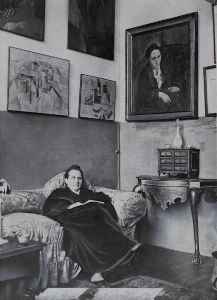
Picasso introduced Stein to Cubism and she, in turn, played a key role in furthering the movement through her writing. While many were critical of his early experiments, Stein grasped the significance of what Picasso was on the cusp to achieving. For instance, while there was near universal criticism of his "ugly" prototype Cubist work Les Demoiselles d'Avignon (1907), Stein offered support: "in the effort to create the intensity and the struggle to create this intensity, the result always produces a certain ugliness, those who follow can make of this thing a beautiful thing because they know what they are doing, the thing having already been invented, but the inventor because he does not know what he is going to invent inevitably the thing he makes must have its ugliness". Not known for her modesty, Stein later told Picasso that "there are two geniuses in art today, you in painting and I in literature".
Picasso's experiments in Cubism would mark the point at which sister and brother parted ways. Leo could never fully endorse the Cubist style and he became more and more disinterested in modern art. As Hobhouse noted, "the advent of Cubism marked the end of Leo's career as a crusader for the avant-garde in painting", while for Stein it marked her independence as a major player in the art world. Indeed, Hobhouse argued that "For years she had sat patiently taking a secondary role in the goings-on at the rue de Fleurus. Now she began to tire of his leadership [...] Cubism was a game she could play without her brother".
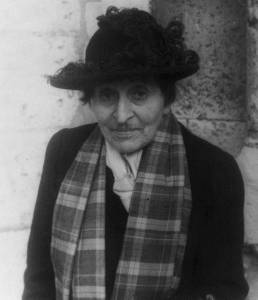
A major event in Stein's life occurred in the fall of 1907 when her sister-in-law Sally brought Alice Toklas, a woman she had met while on a recent trip to San Francisco, to visit the apartment. The two took an immediate liking to each other and began a romantic relationship that would last the rest of their lives. Moving in a year later, Toklas supported Stein by transcribing and editing her writing.
As her role as a major influencer of modern art was being cemented, Stein's creative writing began to gather momentum with her first, and many believe to be her most important, novel Three Lives published in 1909. Three Lives comprised of three short stories exploring the essence of human relationships (of which "Melanctha", the story of a young mulatto girl who engages in a doomed affair with a black doctor was singled out for special recommendation by the likes of the famous Harlem Renaissance writer and critic Carl Van Vechten). Combining both her passions (writing and art), a selection of her writings were focused on artists and the art world, the earliest being her series of brief summaries on the life of some of her artist friends which she aptly called "portraits". Taken with her growing reputation, the art dealer and photographer Alfred Stieglitz featured images from her art collection, accompanied by her written "portraits" of Matisse and Picasso, in a 1912 edition of his Camera Work magazine. Another of her American advocates was the art patron Mabel Dodge. To coincide with New York's first Armory Show in February 1913, Dodge arranged for an article on Stein to feature in Arts and Decoration magazine. At the same time, Dodge praised Stein in an interview with reporter Carl Van Vechten (a future friend and champion of Stein) for the New York Times. Stein's "portraits" had brought her a certain mystique and, for Americans, the excitement and controversy the Armory Show evoked saw the name of Gertrude Stein inextricably linked with the avant-garde and making her the person to meet when in Paris.
Stein was at the very center of the rise of modernity in both art and literature but her new status also brought personal trials. Her relationship with Leo, which had started to disintegrate following her relationship Toklas, was only exacerbated by her love of Cubism, and Leo's dislike of her experimental writing style. Their relationship came to a permanent end in 1913 when he moved out of the apartment after dividing up their art collection (with Gertrude of course taking the Picassos).
During the First World War, Stein worked for the American Fund for French Wounded. Knowing she could best serve as a supplies driver, in 1917 she purchased a car which she named "Auntie" (after her Aunt Pauline, because, as Stein reasoned, "[Pauline] always behaved admirably in emergencies and behaved fairly well most times if she was properly flattered"). According to Hobhouse, Stein made friends with many of the wounded soldiers and she shared a particular affinity with the American GIs. She also did all she could to support her artist friends financially and by helping to arrange the sale of Cubist paintings by Auguste Herbin and Juan Gris (who was experiencing acute financial hardship and ill health).
Following the war, Stein's circle of friends had disintegrated and Cubism had begun to fall out of fashion ("it was a changed Paris. Guillaume Apollinaire was dead" bemoaned Stein). It proved a very difficult period for Stein who did not take to the avant-garde's move towards abstraction, declaring, "the minute painting gets abstract it gets pornographic". Stein had an intense aversion to the Surrealists and the Futurists of whom she wrote, "the surréalistes are the vulgarisation of Picabia as Delaunay and his followers the futurists were a vulgarisation of Picasso". Stein did find some appeal in Neo-Romanticism, however, and though she soon lost interest in the movement, two of the artists she had supported, Eugène Berman and Pavel Tcheltichew, created portrait sketches of Stein as a gesture of appreciation for her support.
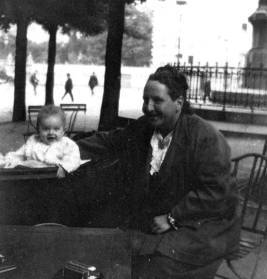
After the war, Stein's reputation as a writer continued to grow. Still the person to be seen with in Paris, she began friendships with two icons of American literature, F. Scott Fitzgerald and Ernest Hemingway. As with Picasso, however, Stein and Hemmingway were of such strong personalities they would often argue, though, according to Hobhouse, Stein, "gave Hemingway enormous confidence in himself as a writer". While she was happy to nurture rising literary figures, Stein also possessed a fierce jealousy of others; specifically James Joyce. According to Hemingway, "if you brought up Joyce twice, you would not be invited back. It was like mentioning one general favourably to another general".
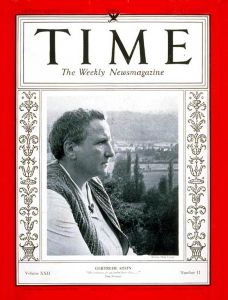
True literary success came to Stein in 1932 when she published her book, The Autobiography of Alice B. Toklas. Written as if it was Toklas's own story, the book was in fact Stein's autobiography. The impressive book sales meant that for the first time Stein had real money to spend: "first I bought myself a new eight cylinder Ford car, and the most expensive coat made to order by Hermes and fitted by the man who makes coats for race horses for Basket [her dog] and two collars studded for Basket. I had never made any money before in my life and I was most excited".
Despite its popularity, the publication of The Autobiography of Alice B. Toklas caused bad blood between Stein and several of her friends and acquaintances. In February 1935 Georges Braque, Eugene Jolas, Maria Jolas, Henri Matisse, André Salmon and Tristan Tzara responded by jointly publishing a pamphlet entitled Testimony Against Gertrude Stein in which the contributors offered a detailed list of rebuttals of Stein's memoirs. Introducing the article, Eugene Jolas wrote "Her participation in the genesis and development of such movements a Fauvism, Cubism, Dada, Surrealism, Transition etc. was never ideologically intimate and, as M. Matisse states, she has presented the epoch "without taste and without relation to reality". Stein had, for example, dismissed Braque as "a facile [...] Picasso" to which Braque responded by stating that "Miss Stein obviously saw everything from the outside and never the real struggle we [Braque and Picasso] were engaged in". He concluded that for "one who poses as an authority on the epoch it is safe to say that she never went beyond the stage of tourist". The book caused the loss of friendships within her literary circle too. She had described Hemingway as "fragile" and "yellow" to which, with a caustic pun on Stein's most quoted line of literature, "Rose is a rose is a rose", he responded by sending her a copy of his treatise on bullfighting, Death in the Afternoon, with a handwritten inscription that read "Bitch is a Bitch is a Bitch is a Bitch".

Notwithstanding its' personal costs, the book's commercial success allowed Stein to undertake (with Toklas) a lecture tour of some thirty American universities between October 1934 and May 1935. Drawing heavy press attention - who routinely referred to Stein by her preferred pseudonym "Sybil of Montparnasse" - the tour allowed her to socialize with many important figures including Frank Lloyd Wright (in Wisconsin), Charlie Chaplin (in Hollywood) and First Lady Eleanor Roosevelt who invited Stein to tea at the White House.
Later Period
When Stein returned to Paris in the summer of 1935 her life had changed significantly. While many of her friendships had been lost with the publication of her biography, she was more troubled by the change in Picasso who had aligned himself with the Surrealists and had, for the most part, given up painting to pursue poetry. Perhaps angered (or jealous) that he was encroaching on her territory, she refused to offer her opinion after he gave a personal reading at her apartment. Picasso later sent his friend Salvador Dalí to meet her in the hope that she might share her opinion with a third party on his poetry. She told Dalí, "I was bored with the hopelessness of painters and poetry. That in a way was the trouble with the painters they did not know what poetry was". Angered by her lack of support, Picasso did not speak to Stein again for several months until they made up over a chance meeting at an art gallery. Not long after, in 1938, Stein wrote Picasso, her biography of the artist.
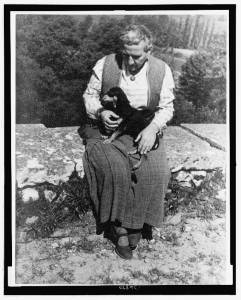
The outbreak of World War Two caused Stein to leave her Paris apartment for the small town of Bilignin near the French/Swiss border. Stein did what she could to help American GIs with her friend Virgil Thomson recalling how, "Every day, as she walked her dog [she] asked them questions, took them home [and] fed them cake and whiskey". According to Hobhouse the soldiers were equally taken with Stein: "they called her Getty and spoke freely to her, some as to a celebrity of whom they had known ten years ago, some as to an extraordinarily wise (and sometimes slightly dotty) old lady".
As an American Jew living in occupied France this was a precarious time for Stein. While the Bilignin townspeople liked her and helped hide her identity, it is believed her friend, the historian and member of the Vichy government, Bernard Fäy, was most instrumental in protecting her from the Germans. Their friendship would prove controversial however when he was later found guilty and imprisoned for being a Nazi collaborator. Additionally, her support for French leader Philippe Pétain and his Vichy government would temporarily damage her reputation after the war. Of particular concern was a 1942 undertaking in which she began to translate into English the leader's speeches, which, according to Mellows, she did out of "her need to justify Pétain's decision to surrender to the Germans". Though she did not finish the project, the fact that she accepted the work at all suggested an ideological affinity with a leader who had kowtowed to the Nazis.
As the war reached its end, Stein returned to Paris to find her apartment had been raided by the Nazis but her paintings had been thankfully spared (something again believed to have been an intervention by Fäy). Trying to return to something like a normal life, she set about reuniting with old friends, including Picasso. She also captured something of her experiences of the occupation in a book, Wars I Have Seen which was published in America in the spring of 1945 and, in 1946, Brewsie and Willie, which sought to capture the war experiences of American servicemen through spoken word.
While giving a lecture to the US army still stationed in Brussels in November of 1945, Stein became sick with abdominal pains. Doctors diagnosed it as stomach cancer. Months later, back home in Paris, she grew sick again and was rushed to hospital. The doctors thought it too dangerous to operate but Stein insisted they proceed. She died on the operating table on July 27, 1946 aged seventy-two. Her last recorded words were spoken to Toklas as she was being taken into surgery. She asked Toklas: "What is the answer?" Upon receiving no response she added: "In that case What is the question?"
The Legacy of Gertrude Stein
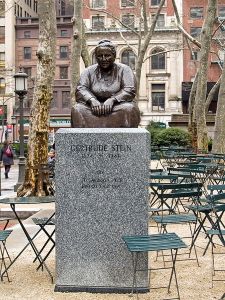
Stein's experimental writings are now generally considered "interesting" rather than important, though her non-linear, Cubist-inspired, style certainly attracted the attentions to some of the most important literary figures of the period, who actively sought out her company. But if her legacy has seen her assigned a supporting role in the history of modernist literature, her influence as a personality and influencer on the "New Moderns" is unequivocal. An imposing, eccentric, figure, Stein was possessed of an unwavering self-belief that allowed her to become a champion for some the most important artists of the time. According to author and critic James R. Mellow, "for their services in exposing modern art to a continuous stream of international visitors - eager young German students, visiting Swedes and Hungarians, wealthy American tourists - the Steins could easily have claimed the distinction of having instituted the first museum of modern art".
In her native America ("America is my country and Paris is my hometown", she once declared) Stein emerged as a champion of the Cubism movement, supporting the works of Pablo Picasso long before most Americans had come to grips this revolutionary ideas. In this respect she was one of the key players in introducing America to European modern painting. She has also become an icon within the gay/queer community on account of her 40-year, documented love affair with Alice Toklas. In the 1980s Yale University made public some 300 love letters between the two women (published later under the title: Baby Precious Always Shines: Selected Love Notes between Gertrude Stein and Alice B. Toklas). Most of the notes were written by Stein (referred to by Toklas as "Mr. Cuddle-Wuddle") for Toklas (referred to by Stein as "Baby Precious") and they are testament to the view, put by Toklas, that "notes are a very beautiful form of literature, personal, provocative, and tender".
Influences and Connections

-
![Pablo Picasso]() Pablo Picasso
Pablo Picasso -
![Juan Gris]() Juan Gris
Juan Gris -
![Henri Matisse]() Henri Matisse
Henri Matisse -
![Francis Picabia]() Francis Picabia
Francis Picabia - Carl Van Vechten
-
![Pablo Picasso]() Pablo Picasso
Pablo Picasso -
![Henri Matisse]() Henri Matisse
Henri Matisse -
![Ambroise Vollard]() Ambroise Vollard
Ambroise Vollard ![Max Jacob]() Max Jacob
Max Jacob![Leo Stein]() Leo Stein
Leo Stein
-
![Félix Vallotton]() Félix Vallotton
Félix Vallotton -
![Marie Laurencin]() Marie Laurencin
Marie Laurencin - Francis Rose
- Pavel Tchelitchew
-
![Guillaume Apollinaire]() Guillaume Apollinaire
Guillaume Apollinaire -
![Alfred Stieglitz]() Alfred Stieglitz
Alfred Stieglitz ![Mabel Dodge Luhan]() Mabel Dodge Luhan
Mabel Dodge Luhan![Ernest Hemingway]() Ernest Hemingway
Ernest Hemingway![Max Jacob]() Max Jacob
Max Jacob
Useful Resources on Gertrude Stein
- Charmed Circle: Gertrude Stein and CompanyOur PickBy James R. Mellow
- Everybody Who Was Anybody: A Biography of Gertrude SteinOur PickBy Janet Hobhouse




















